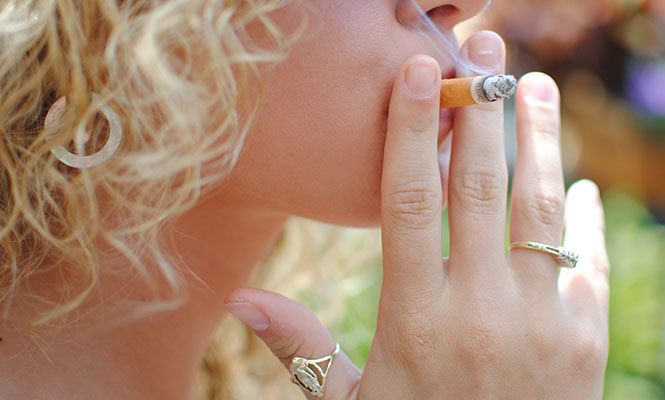LGBTQ smokers more common than heterosexual smokers
February 13, 2014
Members of the LGBTQ community smoke more, than their heterosexual peers possibly because of the stresses of discrimination associated with their lifestyle, according to the 2014 Surgeon General’s report.
However, Kent State LGBTQ students confess to smoking less than the national average.
“When I was at my peak of smoking I spent about $10 a week on cigarettes, the packs are $5 so I roughly bought two packs a week,” said McKenzie Rhodes, a junior fashion design major in the LGBTQ community. “I do not buy my own packs anymore when I do smoke.”
The 2014 Surgeon General’s Report revealed the national spending and usage rates related to cigarette smoking is higher in the LGBTQ community than in the heterosexual community.
LGBTQ Smoking Statistics
● The 2014 Surgeon General’s Report estimated that members of the LGBTQ community spend $7.9 billion on tobacco each year.
● Members of the LGBTQ community smoke cigarettes at rates that are 68 percent higher than the general population.
● Heterosexual women are 2.5 times more likely to smoke weekly, and lesbians are 9.7 times more likely, according to American Lung Association.
● The American Lung Association reported that the tobacco industry targets the LGBTQ audiences through advertising in gay and lesbian publications, as smoking tobacco is often portrayed as a normal part of LGBTQ life.
● The 2014 Surgeon General’s Report estimated that members of the LGBTQ community spend $7.9 billion on tobacco each year.
● Members of the LGBTQ community smoke cigarettes at rates that are 68 percent higher than the general population.
● Heterosexual women are 2.5 times more likely to smoke weekly, and lesbian or gay girls are 9.7 times more likely, according to American Lung Association.
● The American Lung Association reported that the tobacco industry targets the LGBTQ audiences through advertising in gay and lesbian publications, as smoking tobacco is often portrayed as a normal part of LGBTQ life.
*Sources: American Lung Association
2014 Surgeon General’s Report: http://www.lung.org/stop-smoking/tobacco-control-advocacy/reports-resources/tobacco-policy-trend-reports/lgbt-issue-brief-update.pdf
According to the Surgeon General’s Report, members of the LGBTQ community spent an average of $7.9 billion on cigarettes in one year.
“When I was with one of my ex-girlfriends I smoked a lot more, because she smoked a lot,” said Rhodes. “I believe she smoked a lot more because of the stress of overall life.”
Roxie Patton, program coordinator of Kent State’s LGBTQ Center believes the smoking among the LGBTQ community has greatly increased.
“From experience I have seen an increase of smoking cigarettes in the LGBTQ community,” said Roxie Patton. “I believe this is directly tied to the discrimination, lack of parental support and struggle to find their place in society.”
Junior Fashion Design major Evan Sommers said he sometimes smokes at parties if he is around friends who have cigarettes but he never buys a pack himself.
Sommers believes that a common reason for smoking in the LGBTQ community is related to image concerns.
“I think gay guys are more concerned about their status and how they look to people, it may be because they want to look cool,” said Sommers. “I think overall we all want to fit in and be accepted, so if heterosexual people are smoking more, we want to smoke more as well.”
According to the Network for LGBTQ Health Equity, smoking has become one of the biggest health problems among the LGBTQ community.
Bisexual men and women have the highest percentage rate cigarette use out of any subgroup, according to the American Lung Association. The smoking rate on this group peaked at 39 percent. Smoking among gay and bisexual men is 27 to 71 percent higher, and for gay and bisexual women, the rate is 70 to 350 percent higher.
“I do not smoke habitually, but I do occasionally mostly due to stress,” said, Brandon Stephens, president of PRIDE!Kent and junior political science and criminal justice double major at Kent State.
Stephens believes the cause for smoking cigarettes in the LGBTQ community is on the rise because of a combination of life’s everyday stresses and the discrimination the community faces.
“Smoking is obviously not an appropriate stress reliever for anyone,” said Stephens. “This tactic does not solve the stress related issues, and we should be focused on how to improve this.”
Patton said Twenty-five percent of homeless youth in America are a part of the LGBTQ community.
“There are homeless young adults in the LGBTQ community who currently attend Kent State University,” said Patton.” “They are living out of cars, safe houses or shelters because their parents have rejected them.”
According to the American Lung Association, the LGBTQ community needs to be recognized as a priority community in reducing the use of tobacco.
Organizations like the American Lung Association offer solutions to reduce the amount of smoking. It suggests that state and local healthcare systems include LGBTQ representatives from LGBTQ organizations to aid in the planning of solutions to the issue at hand.
According to the Huffington Post, the NYC Coalition partnered with the NYC Department of Mental Health and Hygiene and the American Cancer Society to form the NYC Smoke-Free Initiative. This group was formed to raise awareness and educate the community on the issue.
“Many support systems that are available for heterosexual people are not acceptant to people of the LGBTQ community,” said Patton. “So the lack of support leads to alcohol abuse, substance abuse and self harm simply because these people have no outlet.”
Kara Taylor is a diversity reporter for the Daily Kent Stater. Contact Kara at [email protected].












